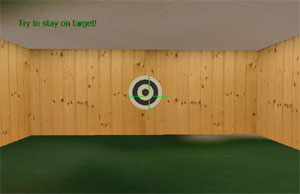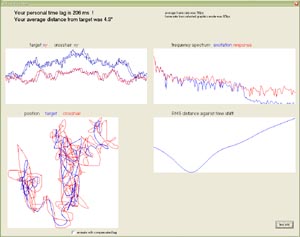|
Version 2006/10/29: - made crosshair smaller - if it finds image files 'crosshair', 'target', 'wall1', 'ceil', 'floor' either as .jpg or .bmp in the reaction.exe directory it will load and use them. These images have to have 2^n pixel size, for instance 256x256. Black is interpreted as transparent. Version 2005/03: - more accurate timing - no dependency on the 'wait for VSynch' anymore. I have taken care to compare your reaction with what is actually visible on the screen at any time (except delays of the monitor). This is a toy program to test your reaction speed or, more precicely, your eye-to-hand delay time under 'realistic' conditions. You could call this delay time your 'personal ping' from eye to hand as it is also expressed in milliseconds (ms). The program is written in Delphi and uses OpenGl. Todays graphics cards should have no problem with rendering that few polygons with full refresh rate. You are free to enable 'wait for vsynch' in the graphic cards properties. For a physicist like me the project is interesting because the program can determine you personal amplitude and phase response. While working on this, I wondered why I got results differing by ~20ms when running the program on my notebook and my full grown PC. The essence is, my large TFT screen adds another delay time to the graphics output! It seems to store at least one full frame before displaying it! For a pro gamer this effect should make a huge impact and ought to be considered by selecting a monitor and should be covered in tests and hardware reviews! For assessing this I implemented a function to the program that can measure the intrinsic delay of the whole loop: drawn graphics - display on screen - optical mouse - mouse driver and windows message system. More about experimenting with the screen-mouse loop-back. | |
 |
You must try to follow the unpredictably moving target analogous to the way you must aim on a wildly jumping opponent in a first person shooter game.
I wrote this program because I was interested in how much faster a skilled player is than I am, the untrained once-in-a-while player.
(As long as I spend my spare time coding OpenGL I will not get any better.)
I admit to achieve at best 200ms of delay time. Most people also achieve values in this region, non-gamers maybe 50ms longer and pro-gamers up to 30ms shorter.
To get a clearer picture of the span of reaction times please mail your result to the email address below! The path that the target follows is a random walk. While you try to catch the target, the actual position of your crosshair is logged and compared afterwards with the path of the target. |
 |
The easiest way to start the test is to simply press the 'quick start>>!' button. The program will switch to fullscreen mode and then it gives you 3 seconds to prepare for the chase. Then the target begins its dance. You just try to follow the target and stay as close as possible to the center. You don't have to shoot at it, its a pacifistic program! The random walk takes about 16s. If you want to use the program in windowed mode press and hold right mouse button to look around. |
 |
After the chase the program switches back to windowed mode and calculates the delay between the 'excitation signal' and your response. This is done by shifting excitation and response to each other in time and calculating the mean (RMS) distance to the target. The curve of all that RMS-distances against the applied time shift can be seen in the expanded window and has a minimum where the searched for time lag is. You can see more of the data extraction when clicking on 'more info'. The value in the second line shows your average (again RMS) distance to the center of the target. For comparison: the diameter of the whole target is 12°. |
 |
Technically the whole process is called a network analysis. A system (you) is fed with a distinct excitation signal and its response is recorded.
The result could be the amplitude and phase response over the tested frequency range. (This will be included sometime.)
In this case the excitation signal is a random walk, a kind of noise, because it behaves very similar to an unpredictable opponent in a FPS game. A random walk has a 1/f frequency characteristic, that means that low frequencies have higher amplitudes than high frequencies. This random walk is symmetric, after half of the time it goes the same way back. This is not necessary for the current least square calculation but is favorable for a cross correlation approach. (not used at the time) Because supposedly noone can follow a random walk with frequency components much higher than 5Hz, I cut off all frequencies above a configurable frequency, at default 5Hz. The movement of the target becomes nicely smooth by this. Another possible and not yet fully implemented approach would be the calculation of the cross correlation between both signals. Other interesting informations could be extracted then too, like phase and amplitude response and the frequency dependance of the time lag. Mind the small moving dots in the lower left graph when you move the mouse cursor over the x/y-time trace (upper left). With the checkbox below you can choose between an authentic replay of your moves and an animation with your lag compensated. |
 |
The settings for resolution, colordepth and display frequency will normally need no change or are self explanatory. Also the renderer settings are there more for
completeness. You can shift 'mouse sensitivity' to the left if you prefer more physical work with your mouse. The checkbox 'restrict to horizontal movement' does exactly that if you like that touch of realism. Some people prefer an inverted control for the vertical look, thats what the other checkbox is for. The editbox 'exc. freq. lowpass' accepts values between 2 and 20Hz. The lower the value the smoother the motion of the target. The motion contains less high frequency components. But towards 2Hz the motion becomes more predictable and the resulting reaction time bcomes shorter. Up to now the prog does not save the configuration data so you have to make the selections after every start again. |
| Just out of couriosity I integrated an aimbot, an automatical aiming system. The aimbot only 'sees' where the target was in the last displayed image and trys to follow the target with the same controls you have. It has no unfair advantage - besides sheer thinking speed. The PID parameters of its regulation loop determine how fast it reacts - between 'dead horse' and supernatural. Aimbot parameters are best set in windowed mode. Don't cheat yourself! :-) | |
Here I compiled some results people published in usenet or sent to me by email.
| name/nick | range ms |
average ms |
average distance to target degrees |
| Adam Balogh | - | 80 | 3.7 |
| med1xza | - | 89 | 1.9 |
| Alexander G. sonyfreak | - | 154 | 4.8 |
| Paul Brocklehurst | 156 | 156 | 4.1 |
| Benjamin Stanka age 30 | 163 | 163 | 4.5 |
| bryan keleman Team1hp_jetset | 165 | 165 | 3.8 |
| Sami "some" Jokela age 24 | 165 - 170 | 167 | - |
| Matvey "TBAPb" Smolovich age 21 | 165 - 175 | 170 | 3.5 |
| Nicholas Borelli | 162 - 180 | 170 | 4.0 |
| Nikk Lovekin Kinematix age 17 | 167 - 170 | 170 | 4.5 |
| Apox77 | 169 - 191 | 170 | 4.5 |
| Torben Maurer miez | - | 170 | 4.9 |
| Jean Bibeau Wrebb | 172 | 172 | 3.8 |
| John "F474L" Burrell | 172 - 185 | 175 | 4.8 |
| Federico Nose | 177 | 177 | - |
| William "R34c710N" Register | 174 - 185 | 180 | 4.4 |
| Tanter Ralf Richter | 179 - 188 | 182 | 5.0 |
| Kevin Lin | 180 | 180 | 3.9 |
| Nathan Moye | 186 | 186 | 4.3 |
| Pjotr K. Presley | - | 195 | 4.3 |
| Peter Hill | 194 - 209 | 200 | 4.4 |
| Greason Maddox | - | 200 | 4.5 |
| myself EMwave in Steam | 195 - 210 | 205 | 4.8 |
| Terrance Schultz | 207 | 207 | 4.0 |
| matt hydes | 211 | 211 | 4.6 |
| nick | range | average |
| fungus | 190 | 190 |
| -=[SFS]=-[Zaknafein] | 197 | 197 |
| Allan Bruce | 200-210 | 205 |
| FaMiNe | 202, 226, 218, 197 | 211 |
| Cookie McCrumble | 218, 218, 218 | 218 |
| Poison64 | 230 | 230 |
| Lief | 235 | 235 |
| myself EMwave in Steam | 220..245 | 235 |
| Andrew Lovern | 260 | 260 |
| Jethro | 270 | 270 |
| Cannon Fodder (67 years old) | 285, 255, 273 | 271 |
| Jordi Xucla | 278 | 278 |